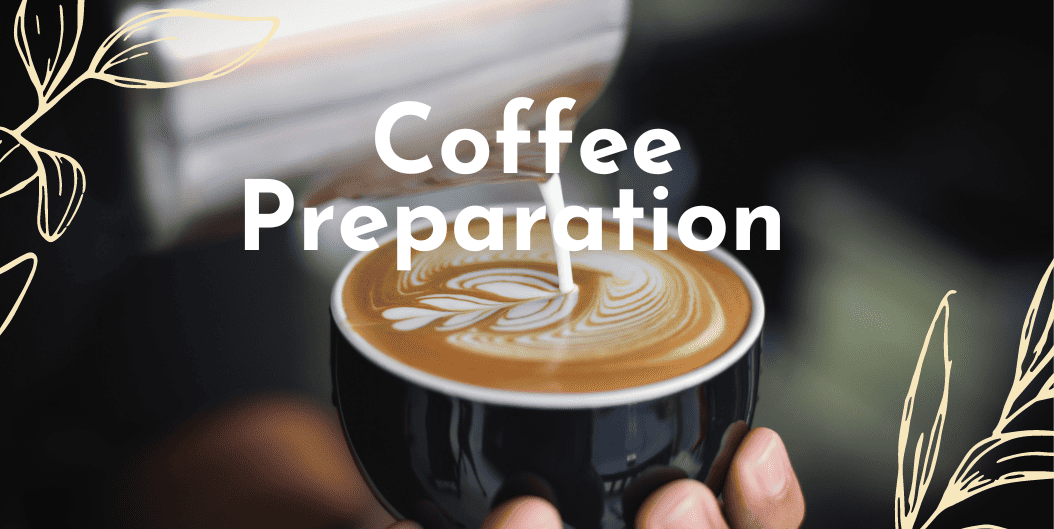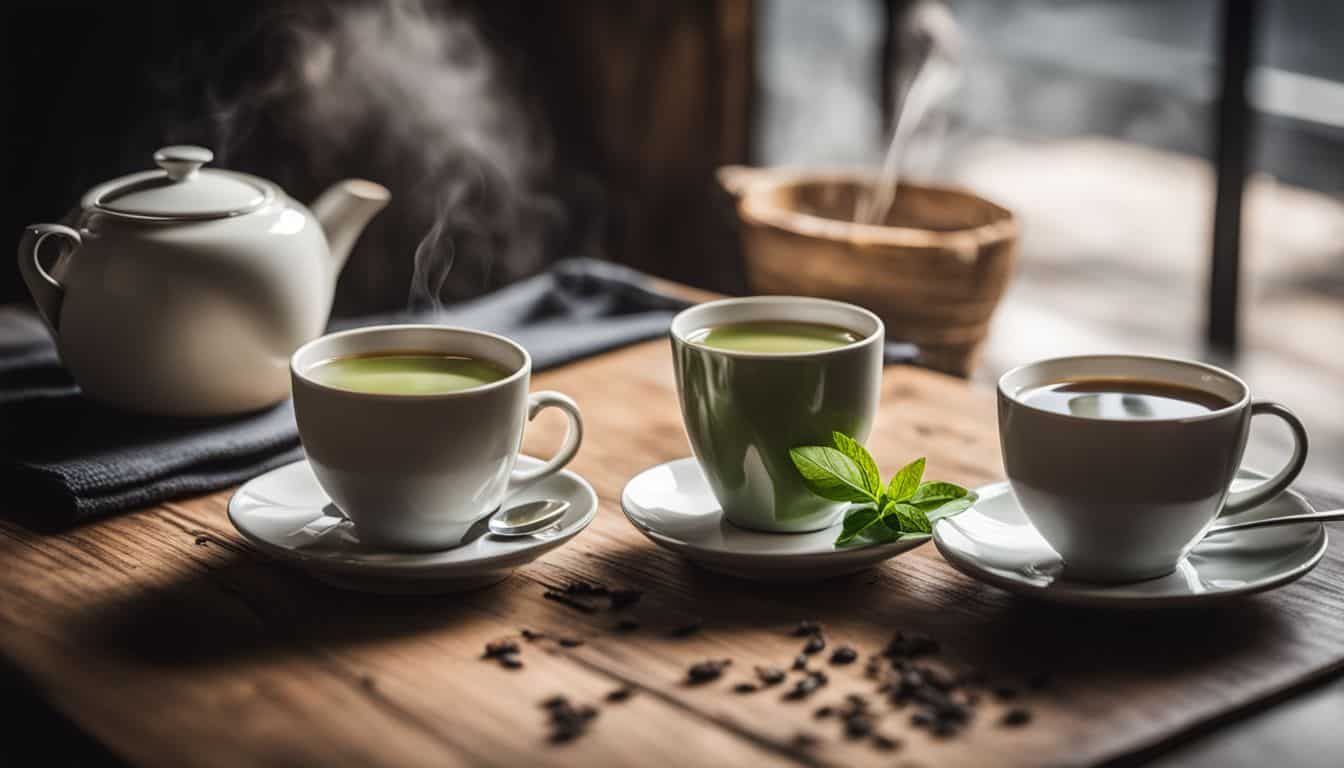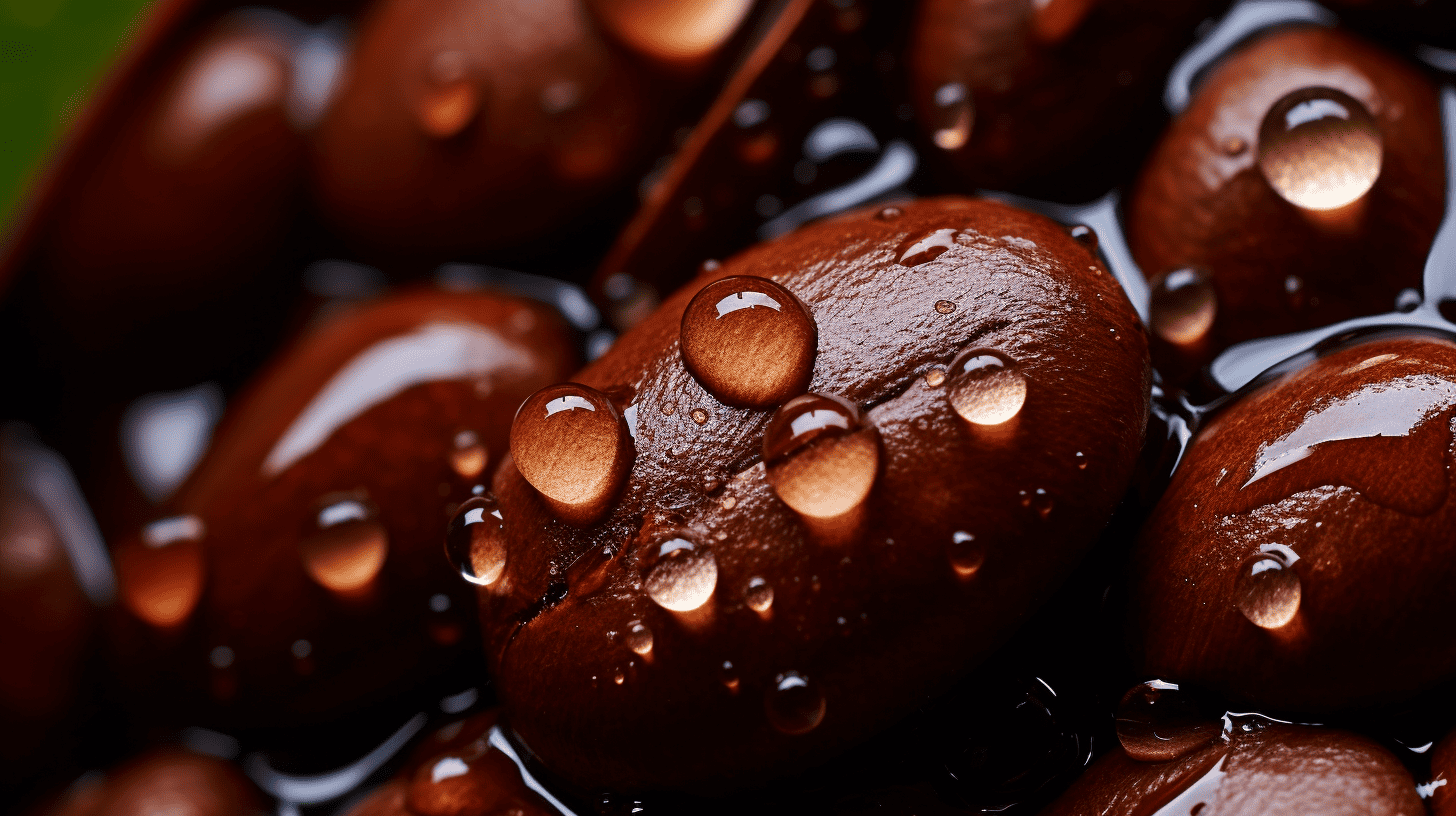Welcome to the world of coffee, where each cup tells a story – a journey that starts from a simple coffee bean and ends with your perfect brew. In this blog post, we will take you on an exciting adventure through the fascinating process of coffee preparation and products to indulge in the beautiful array of products that result from it.
Key Takeaways
Key Takeaways:
- Choosing the right coffee beans is crucial in creating a perfect cup of coffee. Consider single-origin specialty coffees for unique flavors and aromas.
- Understanding the coffee roasting process affects your brew’s flavor and strength. Different brewing methods may require different degrees of roast for optimal results.
- Coffee accessories, such as burr grinders and milk frothers, enhance your coffee experience by allowing you to experiment with different flavors and brewing techniques.
- Pay attention to water temperature, measuring coffee grounds, and avoiding hot or over-frothed milk when making specialty drinks.
Coffee Beans: From Selection To Roasting
– Choosing the Right Coffee Beans: Coffee beans come in different varieties, including Arabica and Robusta; choosing high-quality beans meets your preferences is essential.
– Understanding the Coffee Roasting Process: The roasting process determines the final coffee flavor profile, where light roasts have a mild taste, while dark roast has a robust flavor with less acidity.
– The Importance of Specialty Beans: Specialty coffee is grown under ideal conditions and processes for enhanced quality and unique flavors.
Choosing The Right Coffee Beans
| Consideration | Description |
|---|---|
| Variety | Coffee beans come in three main varieties: Arabica, Robusta, and Liberica. Arabica is the most prevalent and offers a sweeter, more intricate flavor. Robusta delivers a potent, somewhat bitter taste and is typically incorporated in espresso blends. Liberica, though rare, is noted for its smoky, woody flavor. |
| Origin | The geographical origin of coffee beans has a profound effect on their flavor, with each region boasting a unique flavor profile. Renowned coffee-producing regions include Central and South America, Africa, and Asia. |
| Processing Method | The method of processing coffee beans, which can be washed, natural, or honey, significantly influences the taste. Washed coffees are recognized for their clean, bright, and vibrant flavors with pronounced acidity. Natural coffees exhibit a fruitier, sweeter flavor, while honey coffees have a honey-like sweetness with a medium body. |
| Roast Level | The roast level of coffee beans, ranging from light to dark, also impacts their flavor. Light roasts are milder with higher acidity, while dark roasts present a robust, more bitter taste. Medium roasts provide a balance of the two. |
| Freshness | The freshness of coffee beans plays a key role in their flavor. Beans that have been freshly roasted within the past two weeks are ideal. To maintain freshness, they should be stored in an airtight container, shielded from light and heat. |
Embarking on the coffee preparation and exploration journey starts with selecting the perfect beans. Not all coffee beans are created equal; their taste, aroma, and quality can vary tremendously based on origin, variety, and processing method.
Begin by familiarizing yourself with single-origin coffees from specific regions known for cultivating distinct flavor profiles influenced by local climate conditions and farming practices.
For example, Ethiopian Yirgacheffe is renowned for its fruity notes, while Colombian Supremo offers delicate chocolaty undertones. Also, consider your preference in roast levels; light roasts typically have brighter acidity, whereas dark roasts boast more robust flavors.
During your bean selection quest, one key fact to remember is the importance of coffee freshness – constantly look for a roast date rather than “best by” dates on packaging to ensure peak quality and taste (Fact 9).
Understanding The Coffee Roasting Process
The coffee roasting process is where the magic happens. It’s what transforms raw, green coffee beans into the aromatic and flavorful coffee that we all know and love.
Heat is applied to the beans during the roasting process until they reach their desired color and flavor profile.
The degree of roast affects both the flavor and strength of your cup of coffee. For example, a light roast will have a more delicate flavor with higher acidity, while a dark roast will have a more pungent taste with lower acidity.
It’s important to note that different brewing methods may require different degrees of roast for optimal results. For example, espresso requires a darker roast due to its short brew time and high-pressure extraction method, while drip coffee may be better suited for lighter roasts.
The Importance Of Specialty Beans
Specialty coffee beans are becoming increasingly popular among coffee enthusiasts because they offer unique flavors and aromas. These beans are grown in specific regions under strict conditions, which makes them stand out from other coffee varieties.
Additionally, specialty beans are graded based on their quality, and only the best ones make it to market.
As someone who takes pride in brewing the perfect cup of coffee, I have come to appreciate specialty beans’ ability to provide a rich and sophisticated taste with every sip.
Some examples of specialty coffees include single-origin beans and micro-lot coffees; these options can be traced back to a particular farm or region, giving consumers more insight into their coffee.
Coffee Preparation Methods
Drip coffee makers offer a convenient and straightforward way of brewing coffee. At the same time, the French press allows for a fuller-bodied flavor, and espresso machines cater to those who prefer solid and concentrated shots.
How to Prepare Your Coffee at Home
Video Takeaways:
- Pre-warming the glass and using hot water helps maintain the temperature of the French press coffee.
- Remember that straining the French press coffee ensures a smooth and grain-free brew. Additionally, the presence of crema adds sweetness and enhances the flavor.
- For the pour-over method, it’s important to wet the filter paper before adding coffee and to pour the water in a controlled manner to achieve a pure coffee taste.
- Using a Moka pot may result in a slightly bitter coffee due to the heat applied. Avoid pressing the coffee down too hard or adding too much coffee.
- With the ibrik method, it’s necessary to use fine coffee grounds and slowly dissolve them.
Drip Coffee Makers
One of the most popular ways to brew coffee is with a drip coffee maker. These machines work by heating water and slowly dripping it over ground coffee beans held in a filter.
The resulting brewed coffee drips into a carafe below. Drip coffee makers are versatile, easy to use, and come in various sizes and price ranges.
To ensure you get the perfect cup of drip-brewed coffee every time, remember essential factors like the ratio of water to grounds, water temperature, and grind size. For best results, aim for about 1-2 tablespoons of ground coffee per six ounces of water – but this can be adjusted based on your taste preferences.
Choose high-quality beans that have been freshly roasted and ground before using them in your machine.
French Press
One of my favorite ways to prepare coffee is using a French Press. This method involves pouring hot water over coarse coffee grounds, allowing it to steep for a few minutes, and then pressing down on a plunger to separate the grounds from the liquid.
What I love about using a French Press is that it allows me to control the steeping time, resulting in a richer and more flavorful cup of coffee.
French Presses come in different sizes and styles, making them versatile and great for brewing large batches or single servings. Another advantage of using this brewing method is its simplicity – all you need are coarsely ground coffee beans, hot water, and your trusty French Press! Plus, clean-up is easy as most models are dishwasher safe.
Espresso Machines
I’m a huge espresso fan, and one of my favorite ways to prepare it is with an espresso machine. These machines are specifically designed to brew concentrated coffee by forcing hot water through finely-ground coffee beans at high pressure.
Semi-automatic models tend to be the most popular among home baristas as they provide some level of control over the brewing process without requiring too much skill or experience.
Getting a great cup of espresso from your machine every time takes some practice and patience! I’ve learned that using freshly roasted beans that are properly ground will give you the best results.
It’s also essential to use filtered water heated to around 200°F when brewing your espresso shot.
Pour-Over Methods
I love using pour-over methods to brew my coffee because it allows me to control the timing and temperature of each step. It’s a simple way of brewing coffee that involves pouring water over ground coffee in a filter, allowing it to drip into a cup or carafe below.
The resulting cup is clean and bright with distinct flavors.
One popular pour-over method is the Chemex, which uses specially designed paper filters and a glass vessel for brewing. Another option is a Hario V60, which features spiral ridges on the interior walls that help create optimal extraction.
Both methods require precise measurement of coffee grounds and water and an even pour technique to ensure consistent extraction throughout the process.
Coffee Accessories And Additions
Coffee accessories and additions are essential for enhancing your coffee experience. From the perfect coffee grinder to milk frothers, brewing tools, flavorings, and sweeteners – these accessories will aid you in crafting that perfect cup of coffee.
Coffee Grinders
Coffee grinders are essential for the perfect cup of coffee, as they allow you to grind beans to your preferred coarseness. There are two main types of grinders: blade and burr grinders.
Blade grinders chop the beans with a spinning blade, resulting in unevenly sized grounds that can negatively impact the brew’s flavor.
As someone who enjoys trying different flavors and brewing methods, I find that having a burr grinder is crucial for getting the best results from my coffee. Whether I’m making espresso or pour-over coffee, properly ground beans make all the difference in taste.
Milk Frothers
As a coffee enthusiast, I know that the perfect cup of coffee not only relies on the quality of beans and brewing method but also on other factors such as milk frothing. Milk frothers are essential tools for making specialty coffee drinks like lattes and cappuccinos.
There are three types of milk frothers: handheld, electric, and steam wand. Handheld milk frothers are convenient and affordable but may require more effort to achieve desired foam consistency.
Milk frothing can elevate your coffee experience by creating delicious latte art or adding a creamy texture to your drink. A little tip I learned from my barista friend is never to use hot or over-frothed milk, as it may ruin the flavor profile of your coffee drink.
Instead, cold milk is an ideal starting point for achieving optimal foam density without sacrificing taste.
Flavorings And Sweeteners
As a coffee lover, I personally believe that the best cup of coffee is all about the right balance of flavors. Adding flavorings and sweeteners can be an excellent way to enhance your coffee experience.
Some popular flavorings include vanilla, cinnamon, chocolate, or even pumpkin spice.
Sweeteners are another great addition to your coffee. While traditional sugar remains a popular choice for many people worldwide, there are also alternatives like honey and agave syrup that you can use to sweeten up your brew without adding too much sugar content.
Brewing Tools
As a coffee lover, I know that having the right brewing tools is essential for a perfect cup of coffee. Investing in high-quality brewing tools can make all the difference in your coffee-making experience.
A good coffee grinder helps grind beans precisely, ensuring consistent flavor and aroma.
Another must-have tool is the pour-over kettle, which allows you to control water flow while pouring over your grounds. This ensures maximum extraction and better-tasting coffee.
And let’s not forget about scales! Measuring out your coffee-to-water ratio accurately is key to achieving optimal flavor intensity and consistency with every brew.
Brewing The Perfect Cup
Proper water temperature and measuring coffee grounds are crucial for the perfect cup, while experimentation with different flavors can add depth to your brew.
Proper Water Temperature
One of the most important factors in brewing a perfect cup of coffee is using the right water temperature. If the water temperature is too low, you won’t extract enough flavor and aroma from the beans.
The ideal range for water temperature when brewing coffee is between 195°F to 205°F (90°C to 96°C). This temperature range ensures that your coffee is brewed correctly without over or under-extracting flavors.
You can use a thermometer to measure your water temperature accurately before adding it to your coffee maker or pour-over brewer. Alternatively, some machines have built-in heating elements that automatically maintain an optimal brewing temperature.
Measuring Coffee Grounds
Measuring coffee grounds is a crucial step in the coffee brewing process. It ensures consistency and accuracy, ultimately resulting in a perfect cup of coffee every time.
The standard measurement for brewing coffee is two tablespoons of ground coffee per six ounces of water, which yields a medium-strength brew.
Use a kitchen scale or spoon to ensure precision when measuring the grounds. Inaccurate measurements can result in over-extraction or under-extraction of your coffee beans, leading to an unbalanced cup.
Additionally, too much water can dilute the flavor, while using too little can produce a powerful taste.
Steeping Times
Steeping time plays a crucial role in brewing the perfect cup of coffee. The amount of time that coffee grounds are in contact with water can significantly affect the taste and strength of the final product.
Espresso machines utilize high pressure and shorter brewing times, usually 20-30 seconds. Pour-over methods often involve manual control over the flow rate and can take 2-5 minutes, depending on personal preference.
Experimenting with different steeping times is essential to find what works best for your taste buds.
Coffee-to-Water Ratio
One of the most critical factors affecting the taste and quality of your coffee is its coffee-to-water ratio. This refers to how much ground coffee you use in relation to the volume of water used for brewing.
For example, if you’re using a French press and want to brew one cup (8 ounces) of coffee, you’ll need around 14 grams (or two tablespoons) of ground coffee beans and approximately 250 milliliters (or one cup) of water.
Keep in mind that experimenting with different ratios can enhance or alter the flavor profile of your brew.
Experimenting With Flavors
When it comes to brewing the perfect cup of coffee, experimenting with flavors can take your experience to new heights. There are numerous flavor profiles to explore, ranging from earthy and nutty tones in darker roasts to bright and fruity notes in lighter ones.
It’s essential to note that when experimenting with flavors, finding a balance between them is key. Adding too much flavoring can overpower the natural taste of the coffee itself.
Additionally, using high-quality beans ensures that any added flavors are not masking subpar quality coffee. Experimenting with different brewing methods and adjusting ratios of water-to-coffee grounds also plays a role in bringing out particular flavors or notes within the drink.
Exploring Different Coffee Products
Discover the diverse world of coffee products as we delve into the distinct flavor profiles and preparation methods of drip coffee, espresso, cappuccino, latte, Americano, and cold brew.
Drip Coffee
Drip coffee is one of the easiest and most popular ways to brew coffee. It involves pouring hot water over a basket of ground coffee beans, seeping through and dripping into a carafe or mug below.
The quality of drip coffee can be influenced by factors such as the grind size, the temperature of the water, and the brewing time.
To get an excellent cup of drip coffee, it’s important to start with high-quality beans that are freshly roasted and ground just before brewing for maximum flavor extraction.
Also crucial is getting your ratios right- using 2 tablespoons per 6 ounces of water will give you a decently strong cup without becoming overly bitter.
Espresso
Ah, the beloved espresso – a staple in the coffee world. This concentrated and intense shot of coffee is made by forcing hot water through finely-ground coffee beans under high pressure.
Espresso machines come in different varieties, including manual and automatic. Manual machines require you to grind and tamp the coffee yourself, creating a truly hands-on experience.
On the other hand, automatic machines do all the work for you with just the touch of a button.
Most importantly, though, make sure to use freshly roasted beans when making your espresso shot. Since this brewing method extracts such intense flavors from your grounds, it’s essential to use high-quality beans that complement each other well.
Cappuccino
Cappuccino is a popular espresso-based drink that originated in Italy. It consists of three equal parts: one-third espresso, one-third steamed milk, and one-third frothed milk.
To make a perfect cappuccino, it is important to start with freshly ground quality coffee beans. The espresso shot needs to be extracted at a high pressure and served in a small cup.
The milk should be steamed until it reaches 150-155°F and then poured into the espresso shot.
Cappuccinos are often enjoyed as a morning beverage but can be consumed any time of day.
Latte
Ah, the beloved latte. This popular coffee drink comprises espresso and steamed milk with a layer of frothed milk on top. It’s a perfect choice for those who want to indulge in something sweet and creamy while still enjoying the strong flavor of espresso.
To make a latte, first, pull one or two shots of espresso into your cup. Then steam your desired amount of milk until it reaches around 150 degrees Fahrenheit, creating microfoam that will give your latte its signature velvety texture.
Pour the steamed milk over your espresso shot(s), holding back any foam with a spoon to create an even surface.
Latte has become so popular that variations have emerged like caramel lattes or pumpkin spice lattes during seasonal periods, which incorporate extra flavors beyond the basic ingredients mentioned above.
Americano
One of my personal favorites is the Americano. It’s a simple yet delicious coffee perfect for those who prefer a milder taste than espresso shots.
You’ll need one or two espresso shots to make an Americano, depending on how strong you prefer your coffee.
The name “Americano” comes from the World War II era when American soldiers stationed in Italy diluted their espresso shots with hot water to mimic the drip coffee they were used to back home.
Today, it’s become a popular coffee drink worldwide, appreciated for its versatility and easy preparation method.
Cold Brew
One of my favorite coffee products is cold brew. Unlike classic drip coffee, cold brew involves steeping coarsely ground beans in cold water for up to 24 hours.
To make cold brew at home, you’ll need a few critical pieces of equipment like a large glass jar or French press, coarse coffee grounds, and filtered water. Mix the grounds with the water in your chosen vessel and let it sit in the fridge for around 12-24 hours before straining out the solids and enjoying over ice.
Conclusion And Recommendations
In conclusion, coffee lovers can attest that making the perfect cup of coffee requires more than just putting some water and coffee grounds together. The journey from bean to brew is exciting and involves many stages, including selecting the right beans, roasting them to perfection, and preparing them using various methods.
With numerous accessories and additions available today, it’s easier than ever to experiment with different flavors and brewing techniques.
Trying out single-origin specialty coffee is highly recommended for those who want a truly unique experience. Consider water temperature and measure your coffee grounds for optimal results.
FAQs on Coffee Preparation and Products:
1. What are the different methods of preparing coffee?
There are many ways to prepare coffee, including drip brewing, French press, espresso machines, and pour-over methods. Each method has its unique flavor profile and is suitable for different preferences depending on personal tastes.
2. Can I use any beans for my coffee?
No, not all types of beans are equal in producing great-tasting coffee. Specialty coffees like Arabica or Robusta varieties have better quality brews than generic blends in supermarkets.
3. How important is the grind level when preparing coffee?
The grind size plays a significant role in determining the final taste of your cup of joe. Different brewing methods require varied coarseness levels ranging from fine powders for espresso machines to coarse grounds suited for French presses.
4. Is it worth investing in high-quality equipment for at-home brewing?
If you value great-tasting coffee and a personalized experience that replicates professional baristas – then yes! Investing in premium equipment such as grinders, brewers, or specialized tools like frothers enables you to create artisanal-style drinks from home rather than relying solely upon cafes or other outlets, which may be inconvenient or expensive over time, especially if multiple cups per day will be consumed regularly at the same location(s).





Leave a Reply